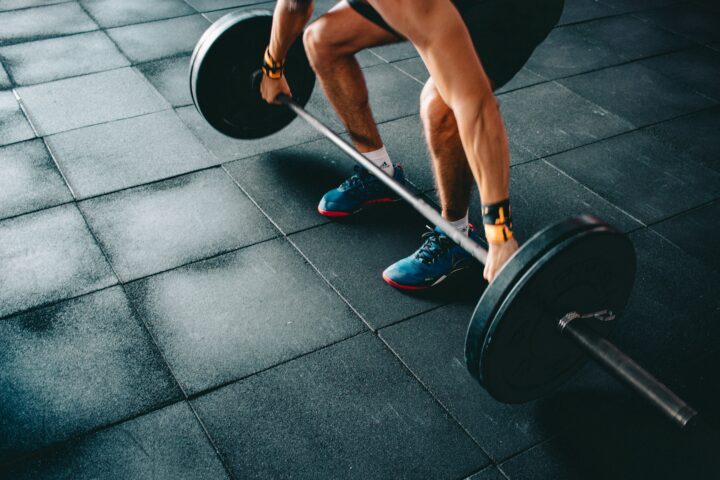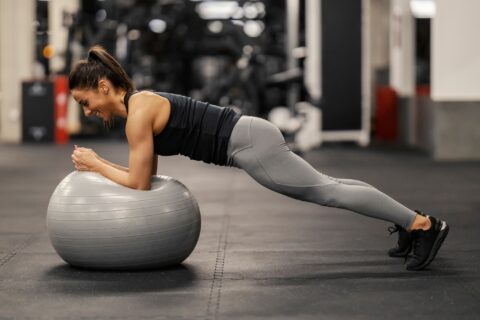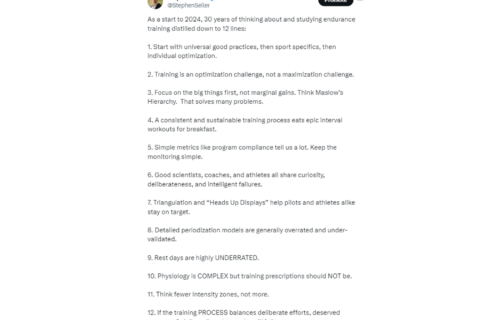In this workshop, find out whether the benefits heat training carry over to racing in temperate environments.
Video Transcript
Intro 00:09
Welcome to Fast Talk Laboratories, your source for the science of endurance performance.
Dr. Stephen Cheung 00:20
Hi, I’m Professor Stephen Cheung, and I am an environmental physiologist who’s made a career of studying the impact of extreme environments, on our physiology and our performance.
Heat Training as Prep for Temperate Environments
Dr. Stephen Cheung 00:31
What we’re going to look at today is the concept of heat training and heat adaptation specifically for racing in temperate or cooler environments. You can find other workshops that I’ve done looking at heat adaptation, in terms of preparing to race in the heat here on Fast Talk Labs. But, today we’re going to take a look at that idea of, “Should we be maintaining a state of heat adaptation throughout the year, even if our racing is going to be in a normal kind of comfortable, temperate environment?” So there’s two questions that we’re going to be addressing. The first is efficacy, does heat training actually improve our ability to race in a temperate environment? The second question is if you do decide to implement heat training, can heat training actually stall or blunt your capacity to train? So in other words, do you need to separate the two, and consider that if you are heat training, you might not be optimizing your training itself? Therefore, you might need to schedule that differently, and we’ll have a separate workshop all about best practices, if you do decide to implement heat training also.
Dr. Stephen Cheung 01:51
Before we get into heat adaptation for temperate performance, let’s just refresh ourselves on what happens with heat adaptation: why might we be even considering this?
Review of the Body’s Response to Heat Training
Dr. Stephen Cheung 02:04
Well, this is a graph that summarizes the findings of two major reviews that have been done on heat adaption in the past 10 years, one of which I was a co-author on. What we have on the horizontal axis is days 1-14. Then on the vertical axis, we have the expected, kind of the general consensus of what happens to different physiological responses over the course of time. So what we see is that, for example, the red line is the heart rate, we see a major decrease in the resting heart rate and also the exercise heart rate. That can occur over as little as seven days, most of the benefits. We see the same other classic response being a decrease in core temperature, which we see in the dark green. Again, that’s at both rest, and during steady state exercise. We also see in the gray, a decrease in skin temperature. At the same time, in the dark blue, we see an increase in the plasma volume, so we have more blood volume in general, and that’s a good thing because it’s going to help blood flow. We also see even in our perception, in the black of thermal comfort, we see an improvement in thermal comfort, so that the same heat stress doesn’t feel as intense or as uncomfortable. Again, all of these changes seem to happen in very short term, so even seven days, you’ve seen the maximize most of these responses. So we do see that short term heat adaptation or STHA a does remain beneficial. But, the longer you can heat adapt, the better, because we have some responses like sweating rate, which we see in the kind of the lighter blue. It only really becomes plateauing after about two weeks. So a little bit as good, up to a week is great, but if you can spread out the two weeks so much the better.
Study Promoting Heat Training for Temperate Racing
Dr. Stephen Cheung 04:14
Let’s take a look at the classic 2010 study by Lorenzo et al from the University of Oregon, that really kick-started this idea that heat adaptation may be a good thing for temperate performance. So what they had, they had individuals perform either 10 days of heat adaptation or 10 days of control. The exercise itself for those 10 days was pretty light any easy, 45 minutes 50% VO2max, so pretty basic endurance training. The heat adaptation group did this in 40 degrees Celsius. The control group did it in 13 degrees Celsius.
Dr. Stephen Cheung 04:49
Now let’s take a look at the heat adaptation group on the left. Again, same graphs, same axis with the pre results on the horizontal axis, the post results on the vertical axis. We see that there was a systematic improvement in the amount of work that you could perform over 60 minutes. This was true, again, whether this time trial was being done in a hot environment, or in a cool environment. So this is pretty strong kind of evidence that this heat adaptation and heat training may benefit not just exercising and competing in the heat, but also if you’re going to be competing in a temperate environment.
Dr. Stephen Cheung 04:49
Let’s take a look at these two graphs and what they mean. On the right is the control group, on the left is the heat adaptation group. What we have here is before and afterwards, they had the participants do a 60-minute time trial with the idea of trying to perform as much work as possible. So we have the pre-test on the horizontal axis, and the vertical axis has the post-test. The main thing to look at with the control group on the right is that there was really no difference before and afterwards. This was true whether these time trials were done in a cool environment with the open circles, or in a hot environment.
Results of the Lorenzo et al. Study (2010)
Dr. Stephen Cheung 06:22
Furthermore, the researchers found a similar pattern of an improvement in the heat adaptation group, but no change in the time trial group with VO2 max, with a lactate threshold, and also maximal aerobic power. So all the kind of performance measures seem to improve in the heat adaptation group. Similarly, in heat adaptation group, they found an increase in plasma volume, in stroke volume, and also cardiac output. Again, this study when it came out in 2010, really ignited this field of saying, “Wow, does heat adaptation actually have a benefit not just for racing in the heat, but also if you’re going to be racing in a temperate environment?” So the Lorenzo 2010 study was pretty convincing that being heated-adapted is a good thing if you’re going to be performing and racing in cool environments.
Study Showing Heat Training Might Limit Adaptation
Dr. Stephen Cheung 07:16
However, contrary evidence was shown by a Danish group by Karlsen in 2015. First off, they had very well trained elite, Danish cyclists, split into two groups: they had a control group, and a heat adapted group. Both groups did an outdoor 43.4 Kilometer time trial in relatively cool environments. Then the control group stayed in Denmark for two weeks, the heat adaptation group went to Qatar in the Middle East and trained there for two weeks. So they came back very heat adapted, and I’m not showing this data, but they definitely improved their performance in terms of in a very hot environment over those two weeks.
VO2 max Data from Karlsen et al. Raises Concerns
Dr. Stephen Cheung 08:04
So what happened when they came back and did this 43 kilometer time trial again, and also did a VO2 max test in the lab, let’s look at the VO2 max data. We see that the heat adapted group had no change in the VO2 max values before and after. The control group however, had a slight increase in their VO2 max after the two weeks of training again in Denmark in a cooler environment. In terms of their time trial power output, neither group had any change before or afterwards in their average power output.
Dr. Stephen Cheung 08:47
So you can take a look at this data and kind of look at it with two ways. The first way if you look at the power output data, you would say that at worst case, heat adaptation didn’t impact your performance, either good or bad. So there was no actual negative impairment on it. So, no harm done. If you can heat it up, that’s great. It might help you but it’s not going to slow you down. However, if we look at the VO2 max values, and data, things get a little bit more kind of blurry, because the control group actually was able to increase their VO2 max value, whereas the heat adapted group did not. So this raises the question of: If we are both training and being in the heat at the same time, are we actually blunting or putting the brakes on our body’s ability to actually absorb the training and adapt and benefit from the training? So that’s a really interesting question. That kind of raises the idea of, maybe there is some harm done with heat training.
Does Heat Adaptation Have an Effect on Hemoglobin?
Dr. Stephen Cheung 10:05
So we’re now going to take a look at another study that suggests that heat adaptation is actually a good thing, regardless of the environment that you’re going to be racing in. So the specific question that’s being addressed here by Bent Ronnestad, from Norway, was does heat adaptation have an effect on our hemoglobin, the oxygen carrying molecule in our body? Does it actually increase the amount of hemoglobin? Which hasn’t really been seen before, and possibly because most of the studies have been very short, have only been about two weeks or so as we saw in a few slides ago. So, Dr. Ronnestad went and quite extreme, and instead of two weeks, they had five weeks of heat adaptation instead. So this is one of the longest heat adaptation studies that has been done, and again, this is an elite level cyclists, which is also very interesting. Heat adaptation took place in 38 degrees Celsius. So again, very hot environments. What we have on the left graph is the total hemoglobin mass, so they actually measured an estimated the total amount of hemoglobin (the oxygen carrier molecule in our blood). They looked at before and afterwards in both the heat adapt group and also the control group. We see the control group on the right, largely no change. However, in the heat adapted group, 9 out of 11, cyclists had an improvement. Also there was an overall improvement in the average amount of hemoglobin that we see. So this is quite novel, this hasn’t really been seen before. Other studies that have looked at hemoglobin with much shorter adaptation periods have not really seen this.
Dr. Stephen Cheung 12:07
What is happening here? The theory is that with this long term heat adaptation, the hemoglobin increases the compensation for the increase in plasma volume. So we see the same response in the in the plasma volume, as we’re seeing in the hemoglobin. On the right there, again, we have the control group, we have a very random mixed bag of responses. Whereas in the heat adapted group, the plasma volume systematically increased in 8 out of the 11 individuals, and there was quite a striking increase in plasma volume. So Dr. Ronnestad, suggests that what’s actually happening here is we have a plasma volume increase, and then over a longer period of time, remember that red blood cells and hemoglobin take a while to be built over those five weeks, with the plasma volume increasing, the body slowly ramped up the increase in hemoglobin and red blood cells. It took about five weeks for that improvement to really express itself. So this is really intriguing because this is kind of the holy grail of what we’re looking for as aerobic athletes that we want the capacity to move oxygen better, and the main way to do that is to increase our hemoglobin.
Is Heat Training the “Poor Man’s Altitude” Training?
Dr. Stephen Cheung 13:32
This is also raises the question of: “Can heat and heat training become the poor man’s altitude training?” Most of us may not be able to actually have an altitude training camp or have access to a hypoxic facility. But, if we can replicate and get to this main primary benefit of increasing our hemoglobin, with sustained heat training, this could be a really interesting thing. So this again, raises the question of if: “We are adapted to the heat, and especially if we’re able to really prolong that heat adaptation exposure, this may actually add/improve our aerobic capacity because of an increase in our red blood cells, and in our hemoglobin.
Can We Optimize Heat Adaptation and Training Response at the Same Time?
Dr. Stephen Cheung 14:22
We saw earlier in the Karlsen study on the Danish cyclists that the control group that trained in a cooler environment had a significant increase in their VO2 max. However, the group that went to training Qatar did not have that increase in VO2 max. In 2021 Slivka kind of followed up on this study and did a really intriguing study to systematically look at this question of: Is it possible to really optimize both heat adaptation and also training response at the same time? If we can, that will be great because then we can kind of make things much more efficient and put heat training at the same time as as normal training itself. So what they did was they had a neutral group that trained for three weeks in 20 degrees Celsius, and they had a heat group that train again for three weeks, 14 sessions at 33 degrees Celsius. So each of the heat training sessions or the neutral training sessions consisted of 60 minutes, riding at a ratings of perceived exertion of 15 on the 6th to 20 scales. This is rates between somewhat hard and hard, so this was a pretty decent bout of exercise to be doing for 60 minutes. Before and afterwards, they had a VO2 max, they also had them perform exercise at 50% of their peak wattage.
Dr. Stephen Cheung 16:00
They also took a muscle biopsy to look at the transcription and response of Trevor’s favorite molecule PGC 1 alpha, which is a key marker of mitochondrial biogenesis or, improvements in our mitochondria itself. So let’s take a look the VO2 max first, we see the response of the neutral group on the left, the heat group in the red on the right. So before the three weeks of training, the VO2 max was quite similar and these are relatively recreationally fit, but definitely not elite individuals. So the VO2 max is about 38 milliliters per kilogram per minute.We see that the neutral group after three weeks of training significantly improved their VO2 Max however, the hot group had no significant change, and indeed, their overall response after three weeks in terms of the VO2 max was lower than the group that trained in a neutral environment.
Dr. Stephen Cheung 17:11
Now let’s take a look at the PGC 1 Alpha, what we have is the kind of the amount of increase in terms of stimulation of PGC 1 alpha on day one, and again, in the final day of testing, in the neutral and a hot group. We see a similar thing that the neutral group on day one had a much higher stimulation of PGC 1 alpha compared to the hot group, and this suggests that training in the neutral environment allows really optimal adaptation in terms of PGC 1 alpha and potentially down the line, the mitochondrial growth. However, we see that after three weeks, whether you were training in a neutral or training in a hot, that PGC 1 alpha response didn’t change, or there was no difference between the two groups. So it may be that there’s a slight improvement in our mitochondrial kind of response to training, especially early on. But overall, this study is really intriguing because it supports the idea that you can’t really juggle optimizing heat training, and also aerobic training at the same time, and that you really need to do one thing at a time. We’ll get a lot more into this in the accompanying workshop.
Takeaways on Heat Training for Performance in Temperate Climates
Dr. Stephen Cheung 18:41
Let’s wrap up this workshop by some take home messages. So again, you can look on the one hand that there is overall no major negative impact from heat training, okay. But, there are some caveats and I’ve pointed them out that you may not be able to juggle heat training and kind of normal aerobic training optimally at the same time. So this really raises the second summary point, which is that proper implementation of heat training, if you are going to go for it is really essential both on a day to day basis, and also in terms of a periodized plan. We’ll be getting a lot more into this in the accompanying video. As always, here’s the references for the studies that I’ve discussed in this video. So this video get you fired up about the concept of heat training for temporary performance? Join our forum with Fast Talk Labs and share your thoughts or questions if you have them. We’d love to hear from you. I’m Professor Stephen Cheung. Thanks for watching!



